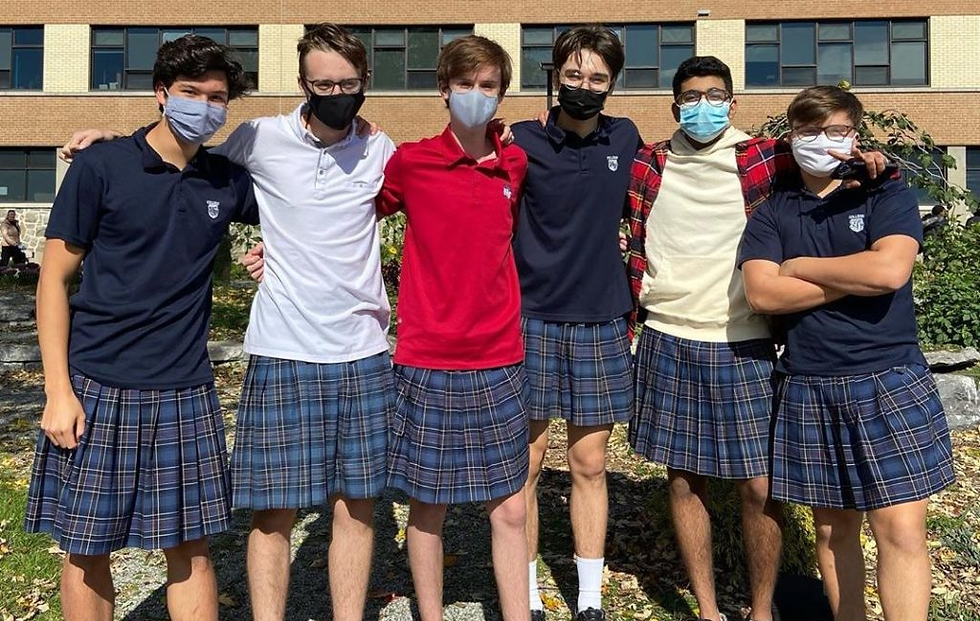It's Not Halloween for Everyone: A Look Into How Other Religions Celebrate This Time of Year
- Tamara Roberts
- Oct 22, 2020
- 4 min read
Updated: Nov 16, 2021
Plastic skeletons, ghost tales, and the full moon: it's that time of year again, Halloween! A fun holiday filled with sugar rushes and last-minute DIY costumes. But let's talk about the “darker” aspects. Halloween is more than candy and daring your friends to go into the neighborhood's haunted house. It's about fear, the unknown, and the supernatural. In this article, we will be exploring Halloween’s mysterious origins. The holiday is celebrated in many countries, including Ireland and the USA. It’s a great time to scare friends, create fond memories of costume mishaps, and get away with over-consuming candy. But did you know that it was not always seen this way?
Halloween comes from a Pagan holiday called Samhain. Paganism put-simply is an umbrella term for many religions, including Wicca, Strega, Druidism, and other non-Abrahamic religions. This eerie festival helped form the spine chilling and popular Halloween we know today. Both these holidays share many similarities. Much like Halloween, Samhain was a day where the supernatural was believed to walk the earth. Furthermore, Halloween is a known day to pull pranks and to trick friends and neighbors. Similarly, in Samhain, performing stunts was also a tradition that was then blamed on malicious and mischievous spirits. Even the custom of putting on costumes comes from Samhain since it was thought to help scare off ghosts with ill intent.
Samhain, believe it or not, is still celebrated today! Samhain was/is a three day (October 31 - November 1) Celtic holiday celebrating the Celtic New year. It marks the “death” of a year and the “rebirth” of a new one. It also has to do with the seasons since Samhain transpires at the end of the harvest and the beginning of winter. The Celtic year (also known as the Wheel of the Year, a more modern term) is divided into two parts of the year: Light and Dark. Two of the annual festivals are in each half of the year. Samhain signals the start of the Dark part of the year, which might sound a bit scary, but in reality is just a period of reflection and introspection.
In the past, Samhain ceremonies included letting the hearth (fireplace) of the home burn while the harvest was gathered. Next, the Druid priests and Pagans would light a big bonfire for all the community to gather around. The fire was made using a wheel to represent the Sun. After the celebration, each family would take a flame from the bonfire to take home so they could relight their hearth. It was and still is believed that during Samhain, the door between our world and the spirit world is at its weakest. That is why a lot of aspects of Samhain and its traditions were about finding protection during this time. Offerings were burned as a shield against ghosts, evil entities, and unearthly creatures. But it’s not as bad as it seems because the blurring of our world and the spirit world means that it's the perfect time for predicting the future (also called Divination). Having the spirit world so close made it easier to see the future for the year to come.
So now that you know a little bit more about this enthralling festival, how did it go from bonfires to knocking on strangers’ houses for candy? Well, by 43 A.D., Christianity had already spread through the Celtic lands. Many of the Pagan festivals were converted into Christian holidays in order to promote the religion. In 609, a holiday called All-Hallows was created to celebrate Christian saints. But Pope Gregory III from the eighth century moved the holiday to precisely coincide with Samhain. It was still celebrated similarly to Samhain, with bonfires and food offerings; however, instead of food offerings for ghosts and old gods, they started being directed to the poor. Over time, this Christian holiday evolved into the Halloween we all love and know today.
But what about modern Samhain? Many Pagan religions have their way of honoring this holy festival, celebrating it differently amongst themselves. Usually, most people will celebrate this day by participating in ceremonies, gathering with close ones, and having feasts. No sacrifices are made, but offerings can be made to an array of deities. Samhain isn't secular like Halloween; it’s a religious and spiritual holiday. It's seen as a day to honor the dead and maybe even try contacting them since the spirit world is supposedly so close to ours. Many say that it’s a great time to build an Ancestor Altar so that you can venerate and keep your Ancestors near. It's also considered an excellent time to visit a cemetery to pay respect to those who have passed to the otherworld with flower offerings. The Feast of the Dead is a popular activity where a tasty dinner is made for the family and an empty seat for loved ones who have passed away is left.
After drawing the common ground between Halloween and Samhain, hopefully, you have come to your own conclusions on the true nature of this time of year. So if you celebrate Halloween, or Samhain (or none), take this time to be with loved ones, honor the deceased, and look out for “otherworldly” spectacles!
Fox, Selena. “Celebrating Samhain.” Circle Sanctuary, Circle Sanctuary, Inc., www.circlesanctuary.org/index.php/celebrating-the-seasons/celebrating-samhain.
History.com Editors. “Samhain.” History.com, A&E Television Networks, 6 Apr. 2018, www.history.com/topics/holidays/samhain.
Lang, Cady. “What Is Samhain? Origin of Halloween Rooted in Pagan Holiday.” Time, Time, 30 Oct. 2018, time.com/5434659/halloween-pagan-origins-in-samhain/.




Comments